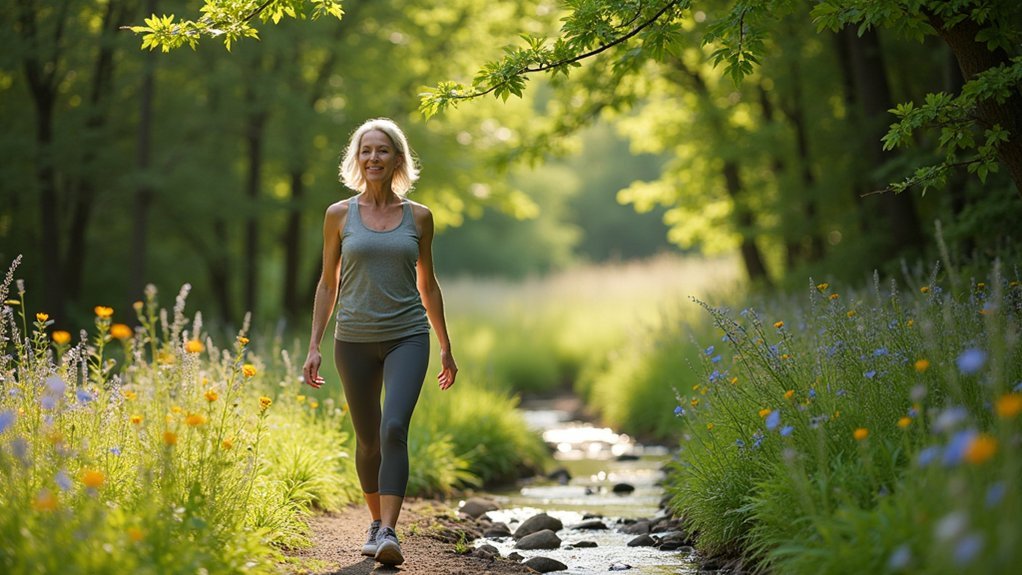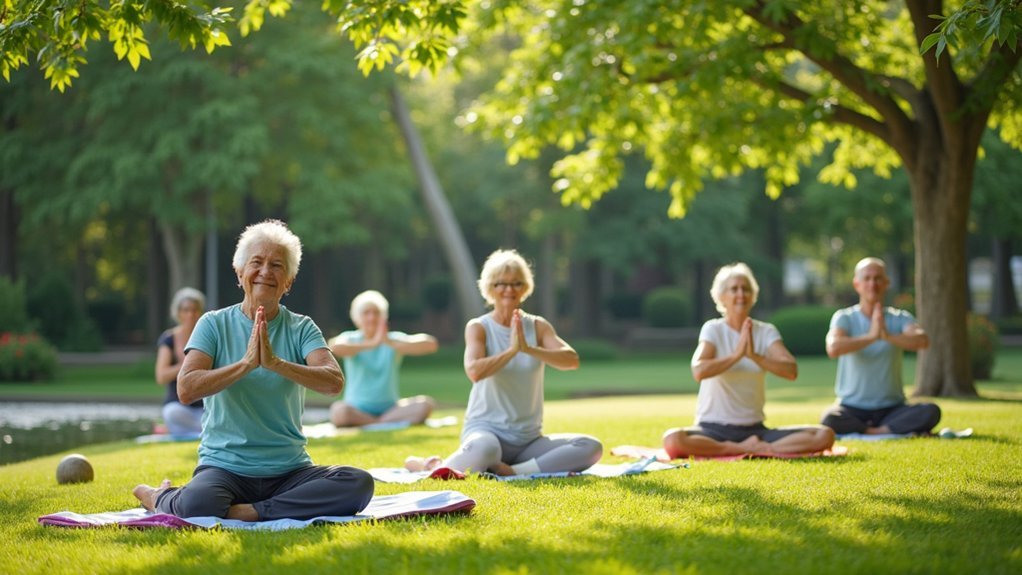Gentle outdoor activities can help manage your arthritis while providing natural mood-boosting benefits. Try walking on nature trails, water walking in lakes or oceans, bird watching walks, tai chi in the park, or seated outdoor yoga. Garden-based stretching, adaptive cycling, fishing, beach strolling, and nature photography excursions all offer joint-friendly movement. These options combine physical benefits with the healing power of nature – discover which activities might become your new favorite therapeutic routine.
Walking on Nature Trails: Easy on Joints, Rich in Benefits

While many exercise options may seem intimidating if you suffer from arthritis, walking on nature trails offers a perfect combination of gentle movement and natural therapy. This low-impact exercise helps lubricate your joints, strengthen muscles, and improve circulation without excessive strain.
Choose smooth dirt trails over hard surfaces to reduce joint stress. You’ll find that outdoor walking provides essential vitamin D from sunlight, which supports bone health while you’re easing arthritis pain.
For best results, walk 30-60 minutes, 3-5 times weekly. Consider using walking poles for added stability on uneven terrain and better weight distribution. They’ll help maintain your balance while providing upper body support during your nature trail excursions.
Water Walking in Natural Settings: Buoyancy for Joint Relief
You’ll find remarkable joint relief when you wade through shallow lake waters, allowing natural buoyancy to cradle your body while strengthening muscles.
The gentle resistance of coastal waves provides an excellent therapeutic workout that’s easier on your arthritis than land-based exercises.
These aquatic environments offer natural hydrotherapy that reduces inflammation while you enjoy the scenic beauty of outdoor settings.
Lake Shore Therapeutic Strolls
For those seeking relief from arthritis pain, Lake Shore Therapeutic Strolls offer a natural alternative to traditional exercises. These specialized water exercises reduce joint impact by 50% through buoyancy, allowing you to move more freely while experiencing less pain.
You’ll benefit from increased joint mobility as you walk through water, which provides gentle resistance to strengthen muscles without stressing your joints. The cardiovascular health benefits are significant—you’re getting a full workout while the water supports your body.
Before joining the arthritis community of water walkers, verify any surgical incisions have completely healed. Most programs include proper technique instruction to maximize benefits and prevent injury.
Beyond physical improvements, you’ll enjoy social connections with fellow participants, supporting your mental wellbeing as your body grows stronger in the therapeutic lake environment.
Healing Coastal Wave Benefits
Beyond lakeshores, coastal environments offer another therapeutic option for arthritis management.
Water walking along shorelines provides remarkable relief as the natural buoyancy reduces joint impact by up to 50%, creating an ideal exercise environment for painful joints.
You’ll appreciate the gentle resistance of coastal waters, which strengthens muscles while improving joint mobility without aggravating your condition.
As you wade through the water, you’re not just exercising—you’re healing.
The peaceful coastal atmosphere enhances mental well-being, making your workout more enjoyable than traditional therapy.
Many find that water walking naturally encourages social interactions with fellow participants, creating supportive communities of people with similar challenges.
Remember to wait until surgical incisions have fully healed before beginning this therapeutic activity to guarantee your safety and maximize benefits.
Gentle Tai Chi in the Park: Flowing Movements for Mobility

You’ll find Tai Chi’s flowing movements can greatly reduce arthritis pain while improving your mobility in outdoor settings.
The deep breathing techniques enhance oxygen delivery to your joints, promoting healing and decreasing inflammation during your practice.
These gentle exercises also strengthen your core and lower body muscles, improving balance and stability that helps prevent falls—a critical benefit for those with arthritis.
Flowing Movements Reduce Pain
While many high-impact exercises can aggravate joint pain, Tai Chi offers a rejuvenating alternative through its fluid, graceful movements that actually help reduce arthritis discomfort.
Research confirms that the gentle, flowing sequences greatly alleviate stiffness and pain while improving your balance and joint mobility.
You’ll notice enhanced flexibility as you practice these controlled movements outdoors.
The natural combination of mindful breathing and gentle motion works to decrease tension in your body, creating a sustainable path to pain relief.
When you establish a regular Tai Chi routine in a park setting, you’re not only addressing physical symptoms but also reducing stress levels that can intensify arthritis pain.
The low-impact nature of Tai Chi makes it an ideal exercise you can maintain consistently, even when other activities feel challenging.
Breathing Enhances Joint Benefits
Deep breathing forms the cornerstone of effective Tai Chi practice, amplifying the therapeutic benefits for your arthritic joints.
When you synchronize your breath with each flowing movement, you’re actively reducing pain while enhancing joint mobility. The outdoor environment adds another dimension to your exercise routine, allowing fresh air to deepen your relaxation response.
To maximize breathing benefits during your Tai Chi practice:
- Inhale slowly through your nose as you expand movements, imagining oxygen flowing directly to stiff joints.
- Exhale completely through your mouth during contracting movements, visualizing tension and pain leaving your body.
- Maintain a consistent breathing rhythm that feels natural—never forced—to promote deeper relaxation.
This mindful breathing technique transforms simple exercise into powerful medicine for arthritis management.
Balance Prevents Fall Risk
The graceful, deliberate movements of Tai Chi offer arthritis sufferers a powerful defense against one of their greatest risks—falling. This ancient practice enhances your balance and coordination through flowing sequences that strengthen the muscles supporting your joints.
When you practice Tai Chi in park settings, you’ll gain more than improved joint health. The natural environment provides fresh air while you work on flexibility and stability.
Research confirms that regular outdoor exercises like Tai Chi greatly improve your ability to maintain balance during daily activities.
Classes accommodate all skill levels, with modifications for those experiencing joint pain or stiffness.
You’ll also find unexpected benefits beyond physical mobility—practicing with others creates community connections that provide emotional support on your arthritis management journey.
Garden-Based Stretching: Combining Productivity With Movement

Gardening offers arthritis sufferers a unique opportunity to exercise without feeling like they’re exercising at all. As you tend to your plants, you’re naturally engaging in garden-based stretching that improves joint mobility while accomplishing something productive.
These gentle exercises can notably reduce stiffness while you work at your own pace.
Gardening’s gentle movements provide natural relief for arthritic joints, allowing you to progress comfortably on your own timeline.
Try incorporating these movements into your gardening routine:
- Perform arm circles before reaching for distant plants to warm up your shoulder joints.
- Practice side bends while watering to enhance flexibility in your torso.
- Take brief stretching breaks between tasks to maximize physical activity benefits.
You’ll also enjoy mental wellness benefits as you spend time outdoors. The stress-reducing effects of nature complement the physical advantages, creating a holistic approach to managing arthritis symptoms.
Seated Outdoor Yoga: Mindful Practice in Fresh Air
For those seeking a more structured approach to outdoor movement, seated yoga presents an ideal option that combines mindfulness with gentle joint-friendly exercise.
When practiced outdoors, this accessible form of yoga provides the dual benefits of natural sunlight for vitamin D production and mood enhancement.
Seated outdoor yoga features gentle movements specifically designed for those with limited mobility, using chairs to provide stability while improving flexibility and joint mobility.
You’ll find the combination of deep breathing techniques and supported poses helps reduce stress while minimizing strain on sensitive joints.
The beauty of this practice lies in its adaptability—you can progress at your own pace while strengthening muscles and reducing stiffness.
Regular sessions may contribute to a more active lifestyle, allowing you to manage arthritis symptoms while enjoying fresh air.
Bird Watching Walks: Pacing With Purpose
While traditional exercise programs might feel tedious or overwhelming, bird watching walks offer arthritis sufferers a purposeful way to stay active outdoors. By moving at a moderate pace while scanning the trees and skies, you’re lubricating joints and building supportive muscles essential for joint health.
Bird watching transforms ordinary walks into engaging adventures that benefit both body and mind:
Bird watching elevates simple strolls into captivating journeys that nurture physical health while soothing the soul.
- Consistent physical activity – The excitement of spotting different species motivates you to maintain your daily 30-minute walks.
- Natural terrain variety – Exploring different habitats challenges your body while connecting you with nature.
- Stress reduction – The calming effect of observing birds improves mental well-being, which can reduce perceived pain.
You’ll find this enjoyable activity doesn’t feel like exercise—yet delivers significant benefits for managing arthritis symptoms.
Adaptive Cycling: Low-Impact Motion on Scenic Paths
You’ll find hybrid bikes offer the perfect balance of stability and comfort with their upright positioning and shock-absorbing features ideal for arthritic joints.
To master pain-free pedaling, focus on maintaining a higher cadence with lighter resistance, which reduces stress on your knees while still providing an effective workout.
Complementing your ride with pre-cycling stretches and choosing scenic paths with smooth surfaces will transform your adaptive cycling experience into both a therapeutic and enjoyable outdoor activity.
Hybrid Bike Options
Finding the right hybrid bike can transform your arthritis management routine into an enjoyable outdoor experience. These versatile bikes offer a comfortable, upright position that reduces strain on your joints while providing stability across various terrains.
You’ll appreciate how they combine the best features of road and mountain bikes, creating an ideal low-impact exercise option.
When selecting your hybrid bike, consider:
- Adjustability – Look for models with customizable seats and handlebars to guarantee proper posture.
- Tire width – Wider tires provide better stability and shock absorption for sensitive joints.
- Alternative designs – Recumbent bikes offer back support while tricycle models eliminate balance concerns.
Regular cycling strengthens muscles surrounding arthritic joints without jarring impact, improving your cardiovascular health while potentially reducing pain and stiffness.
Pain-Free Pedaling Techniques
How can arthritis sufferers enjoy cycling without aggravating their condition? The key lies in proper technique and bike setup. Your joint health depends on maintaining proper alignment while cycling to minimize pain.
| Technique | Benefit for Arthritis |
|---|---|
| Adjust seat height | Guarantees proper knee alignment |
| Use recumbent bikes | Reduces hip and knee pressure |
| Practice gentle intervals | Builds endurance without strain |
| Maintain relaxed grip | Decreases hand and wrist pain |
| Pedal at higher cadence | Reduces force on joints |
Try alternating between easy pedaling and slightly increased resistance to boost your cardiovascular health without stressing joints. Recumbent bikes offer excellent back support while decreasing pressure on painful areas. Remember that adaptive cycling exercises are not just physically beneficial—riding through scenic outdoor paths enhances your mental wellbeing too, making it a complete therapy for arthritis management.
Fishing for Flexibility: Gentle Casting Exercises
Cast away joint stiffness with one of nature’s most therapeutic activities: fishing. The gentle arm movements involved in casting your line can greatly improve your flexibility and range of motion in your shoulders and upper body.
As a low-impact exercise, fishing reduces joint stress while still building muscle endurance.
You’ll enjoy three key benefits when you incorporate fishing into your arthritis management routine:
- Enhanced joint health through repetitive, controlled movements that don’t overload painful areas
- Deep relaxation from spending time in peaceful natural settings, which helps reduce inflammation
- Improved hand and arm strength from the subtle resistance of reeling in catches
The social aspect of fishing provides emotional support, creating a holistic approach to managing your arthritis symptoms.
Beach Strolling: Sand Therapy for Strength Building
While many exercise options can be challenging for arthritis sufferers, beach strolling offers a perfect combination of resistance training and gentle impact. As you walk, the sand creates natural resistance that strengthens leg muscles without stressing your joints—making it an ideal outdoor exercise for managing arthritis pain.
Soft sand engages stabilizing muscles more than firm surfaces, improving your balance and coordination while supporting joint health. The rhythmic motion helps lubricate joints and reduces stiffness, enhancing mobility.
You’ll also benefit from the warm sand and sunshine, which act as natural heat therapy to soothe discomfort.
For maximum benefit, aim for 30 minutes of beach strolling most days of the week. Your cardiovascular system will thank you, and your joints will appreciate this gentle yet effective workout.
Nature Photography Excursions: Movement With Meaningful Pauses
For those who find beach strolling too strenuous or don’t live near coastal areas, nature photography excursions offer another excellent outdoor option for arthritis management.
These outings combine gentle movement with meaningful pauses, allowing you to improve joint mobility while engaging in a fulfilling activity.
Outdoor photography provides three key benefits for arthritis sufferers:
Gentle movement, creative distraction, and self-paced exploration make photography an ideal therapeutic activity for managing arthritis.
- The varied terrain encourages natural stretching and bending, which helps reduce joint stiffness without high-impact stress.
- Focusing on capturing beautiful images distracts from discomfort, turning attention toward creativity instead of pain.
- You can easily incorporate rest breaks when needed, preventing overexertion while still enjoying nature.
You’ll also find opportunities to connect with fellow photography enthusiasts, creating a supportive community that understands the need to balance activity with rest.
Frequently Asked Questions
What Is the Best Exercise for People With Arthritis?
You’ll find walking is the best exercise for arthritis, as it’s low-impact on your joints while improving cardiovascular health. Swimming, cycling, and water aerobics are also excellent alternatives that won’t stress your joints.
What Is the Best Drink for Arthritis?
Water is your best option as it maintains hydration for joint lubrication. You’ll also benefit from anti-inflammatory drinks like green tea and tart cherry juice, which contain antioxidants that reduce inflammation and pain.
Is Walking or Sitting Better for Arthritis?
Walking is definitely better for your arthritis than sitting. You’ll reduce pain, improve mobility, and boost your mood with just 30 minutes of walking 3-5 times weekly. Sitting increases stiffness and discomfort.
Is Peanut Butter Good for Arthritis?
Yes, peanut butter’s good for arthritis. You’ll benefit from its anti-inflammatory compounds, healthy fats, and vitamin E that help reduce joint inflammation. Just choose natural varieties and enjoy it in moderation due to its calories.
In Summary
You don’t need intense workouts to stay active with arthritis. These gentle outdoor options provide joint-friendly movement while connecting you with nature’s healing benefits. Listen to your body, start slowly, and you’ll likely discover improved mobility and reduced pain over time. Remember, consistency matters more than intensity. By making these activities part of your routine, you’re taking control of your arthritis journey one gentle step at a time.





Leave a Reply